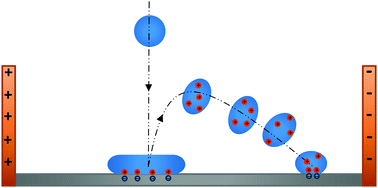Charging of drops impacting onto superhydrophobic surfaces†
Abstract
When neutral water drops impact and rebound from superhydrophobic surfaces, they acquire a positive electrical charge. To measure the charge, we analyzed the trajectory of rebounding drops in an external electric field by high-speed video imaging. Although this charging phenomenon has been observed in the past, little is known about the controlling parameters for the amount of drop charging. Here we investigate the relative importance of five of these potential variables: impact speed, drop contact area, contact line retraction speed, drop size, and type of surface. We additionally apply our previously reported model for sliding drop electrification to the case of impacting drops, suggesting that the two cases contain the same charge separation mechanism at the contact line. Both our experimental results and our theoretical model indicate that maximum contact area is the dominant control parameter for charge separation.



 Please wait while we load your content...
Please wait while we load your content...